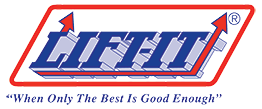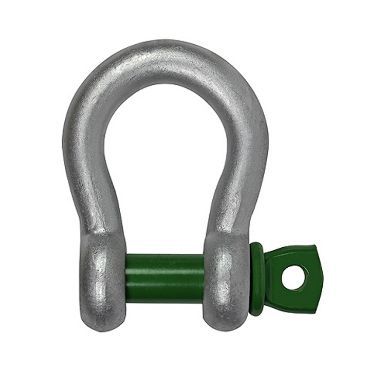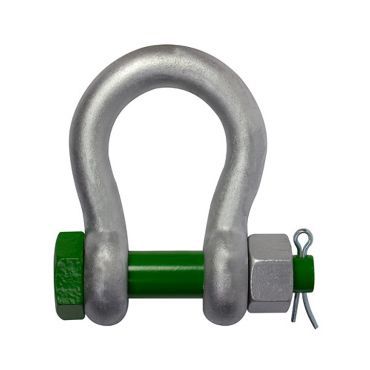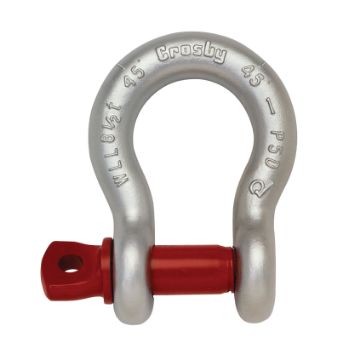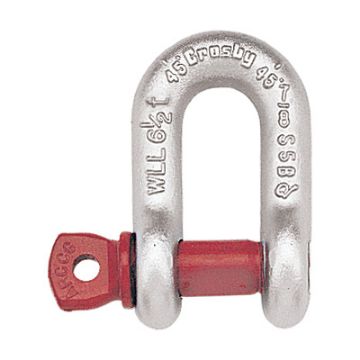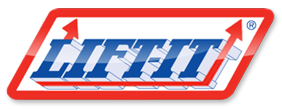Shackles
Shackle Application, Maintenance and Use
Information on Shackle selection, use, and maintenance can be found in ASME B30.26. The standard states that “Shackle users shall be trained in the selection, inspection, cautions to personnel, effects of environment, and rigging practices as covered by Chapter 26-1” This video will not cover everything you need to know about shackles, but is intended to provide you with a brief overview on some of the many important considerations when selecting, purchasing and using high tensile shackles.
A shackle is made up of 4 general components The Bow | Shoulder | Pin | Ear.
There are several body types available when choosing a shackle, today we will discuss Anchor shackles and Wide Body Sling Shackles as well as the two most popular pin styles, Screw Pin and Bolt Type. Both the Screw Pin Anchor shackle and the Bolt Type Anchor shackle are similar in design, however the screw pin design is generally used for quick installation, and features a pin that is secured to the bow by internal threads The Bolt Type Anchor Shackle is used for long term installations and features an external nut and cotter pin. The Wide Body Sling Shackle features a Wider Bow design that greatly improves sling life and efficiency by allowing the sling to load evenly over a larger bearing surface.
Generally, shackles up to 150 US tons have a design factor of 5:1. For shackles over 150 US Tons generally have a 4:1 design factor. Design factors are specified by the US Federal specification, RRC 271D and ASME B30.26.
Carbon or Alloy Steel Shackles?
In the forging process two primary metals are used, Carbon or Alloy Steel. Alloy steel being the stronger of the two. When comparing a carbon shackle to an equivalent strength alloy shackle, the carbon shackle has a larger diameter than the Alloy shackle. Size for size, the alloy shackle will always be stronger than the carbon shackle, giving the end user the option between the economy of carbon shackles or the higher strength and lighter weight of alloy shackles.
Manufacturing Differences Between Drop and Upset Forging
The two primary forging processes used to manufacture shackles are drop forging or upset forging.
Many shackles today are manufactured by using the drop forging process. The drop forging process starts by taking a “slug” which is a cut piece of material that is heated and preformed and then formed between a pair of dies as pressure is applied. Drop forging is very popular for producing shackles however synthetic sling users must always be aware of what is called the “flash line”. The flash line is left behind as a result of the drop forging process. The flash line can damage a synthetic sling under tension.
Upset forging is a comparatively advantageous forging process producing synthetic friendly shackles with no flash line. The process starts out by cutting raw materials to a desired length, heating the material and bending it to the desired shape. Upset forging produces a uniform, smooth finish throughout the entire shackle body making the synthetic sling connection point a damage free surface and unlike upset forged shackles no flash line is left behind.
In Both types of forging, shackles are put through a heat treating process, typically referred to as “Hardening & Tempering” to give the high strength steel materials Strength, Toughness and Ductility needed to obtain the required strength, Work Load Limit and design factor.
All shackles are required to be marked with the proper identification per ASME B30.26. The standard specifically states that each new shackle body shall have forged, cast, or die stamped markings by the manufacturer to show name or Trademark of manufacturer | Rated Load | and Size.
In addition to the required Shackle Body markings the Shackle Pin also is required to be marked with the name or trademark of manufacturer, grade, material type, or rated load.
You must choose a shackle with suitable characteristics for the type of sling, load, hitch, and environment in accordance with the shackle manufacturer’s data.
Rigging Best Practices for Screw Pin Anchor Shackles
Let’s take a look at some of the following accepted rigging practices for screw pin anchor shackles.
The screw pin threads should be fully engaged and tight, the shoulder should be flush and make full contact with the shackle body. Do not back off a quarter turn on the pin before use. Unthreading the shackle pin could result in shackle distortion and exposes threads that could potentially damage synthetic slings If the pin becomes too tight to loosen by hand insert an object through the pin hole and untighten.
For long-term installations, bolt-type shackles should be used, Must bolt type shackles are designed with a cotter pin, the cotter pin shall be used and maintained in good working condition. The cotter pin should never be missing as it is an integral part of the bot-type shackle.
If the shackle is to be side loaded, the rated load shall be reduced according to the recommendations of the manufacturer or a qualified person. Guidelines should be followed from the ASME B30.26 for side loading reductions with in-line shackle loading between zero and 5 degrees there is no rated load reduction and the shackle can be used at 100% of the marked Working Load limit. However when shackle use exceeds a 5 degree angle of loading, you must reduce the rated load capacity for “side loading”.
The rated load for shackles used at 6 to 45 degrees must be reduced by 30%.
The rated load for shackles used at 46 to 90 degrees must be reduced by 50%.
Side loading a shackle over 90 degrees is not recommended. Consult the manufacturer or qualified person.
In addition, contact with edges that could damage the shackle should be avoided. Avoid Shock loading - multiple sling legs should not be applied to the pin. When a shackle is used in a choker hitch, the pin must be connected to the choking eye of the sling and not connected to the bow of the shackle, The eye of the sling is connected to the shackle pin and the sling body is passed through the bow. Make sure that the shackle is not only of sufficient strength, but large enough for the sling body to easily pass through preventing potential edge damage.
Shackle Inspection Levels
Most shackles have a maximum operating temperature of 400 degrees Fahrenheit and minimum operating temperature of -40 degrees Fahrenheit, if temperature exposure outside the acceptable range is anticipated, the shackle manufacturer or a qualified person should be consulted.
There are three levels of inspection when dealing with shackles, Initial, frequent and periodic. The initial level of inspection occurs prior to use and upon receipt for all new, altered, modified, or repaired shackles. The initial inspection shall be done by a designated person to verify compliance with ASME B30.26. A written record at the initial level of inspection is not required.
A frequent inspection is a visual inspection performed by the user or other designated person each day before the shackle is used. If any hazard is detected, the shackle must be removed from service and only returned if approved by a qualified person. Written records are not required for the frequent level of inspection.
Periodic Inspection is a complete inspection done by a designated person based on the frequency of use. The periodic inspection intervals shall not exceed 1 year and the frequency of periodic inspections should be based on the frequency of shackle use, severity of service conditions, nature of lifting or load-handling activities and experience gained on the service life of shackles used in similar circumstances. The guidelines for time intervals are
a) Normal Service – yearly
b) Severe service – monthly
c) Special service – as recommended by a qualified person
Written Records are not required.
Shackles shall be removed from service if any of the following damage is visible and shall only be returned to service when approved by a qualified person.
Missing or illegible manufacturers name, trademark and/or rated load identification. Indications of heat damage, including weld spatter or arc strikes. | Excessive pitting or corrosion | Bent, twisted, distortion, stretched, elongated, cracked or broken load-bearing components | Excessive nicks or gouges | a 10% reduction of the original or catalogue dimension at any point around the body or pin | Incomplete engagement of the pin | Excessive thread damage | Evidence of unauthorized welding | Other conditions, including visible damage that causes doubt as to the continued use of the shackle.
NEVER USE a damaged shackle or questionable rigging.
Lift-It Manufacturing makes it easy to fulfill your requirements for quality shackles with competitive pricing and extremely short lead times. We are the west coast master distributor for Van Beest and stock up to 400 Ton rated shackles!
All products provide by Lift-It Manufacturing are sold with the express understanding that the purchaser and user are thoroughly familiar with the safe and proper use and application of the product. The user is responsible for proper use and application as detailed in all applicable standards and regulations. Use of slings and sling protection by untrained persons is hazardous. It is important that sling users be thoroughly familiar with the manufacturer’s recommendations and safety information that accompany our products. This video does not provide you with all the information you need to know in order to be considered trained and knowledgeable about sling protection and rigging. Remember, when it comes to using slings and/or sling protection, lack of skill, knowledge and care can result in severe injury or death.
